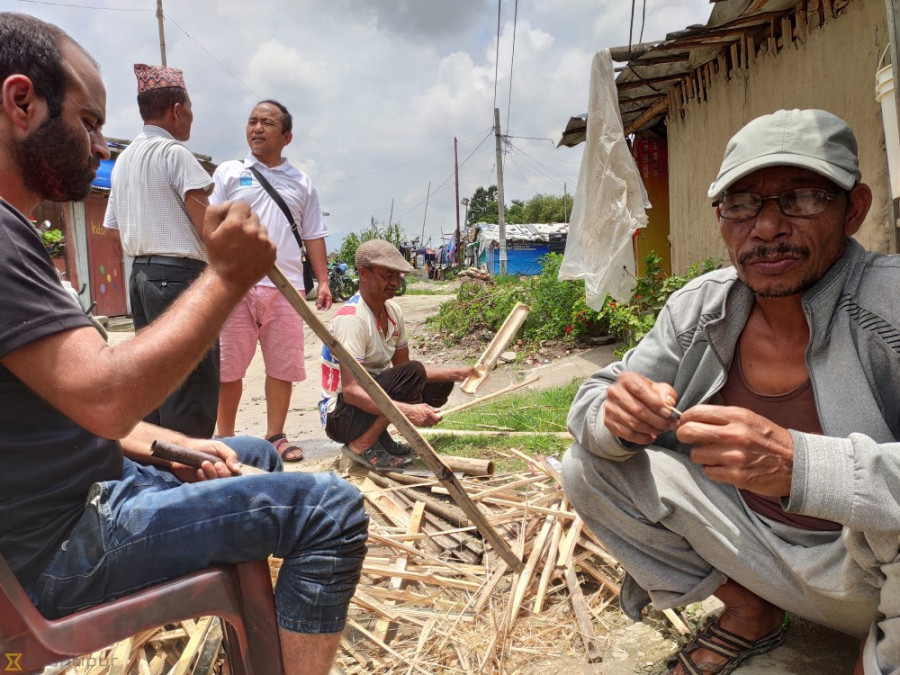Valley
Riverside squatters in Thapathali spend sleepless nights
When water level rises, members of squatter households keep vigil with torch lights
Anup Ojha
On Friday night, Tula Bahadur KC, 53, and his six-member family, who live in a shack at the squatter settlement in Thapathali, didn’t sleep as two days of incessant rain had caused the Bagmati floods to swamp their settlement.
Hundreds of people living in the settlement spent their night on the raised part of the riverbank carrying emergency lights. KC’s wife Maya, 47, remained busy placing buckets to collect water leaking into her hut while her four daughters emptied them outside.
“We experience this problem every year. During monsoon, flood in the river and wind scare us. There is a high risk of malaria, as mosquitoes are ubiquitous in stagnant water that is common here,” said KC, who is a mason by profession. “In winter, we suffer from the stinking river. There are numerous other problems for living here.”
KC’s family came from Dolakha 29 years ago to find a better livelihood in the Capital after a landslide destroyed his little land in the district.
“But ever since we settled on the river bank, we live under constant fear—of government, nature and almost everything,” said KC.
Like KC, hundreds of squatter families living on the riverbank have lived through the same plight. According to the Oppressed Squatter Committee, the Thapathali area has 136 households and a total population of 616.
Chandra Tamang, chairperson of the oppressed committee, said squatter settlements in Balkhu, Banshighat, Manohara, Balaju, Sinamangal, Gaurigaun and Sankhamul are at higher risk of inundation or being swept away by rivers.
According to the Nepal Landless Democratic Union Party, there are more than 29,000 landless people in Kathmandu Valley living in 73 settlements. Of them, 1,082 families were registered as squatters in 2012. According to the union, over 8,000 families are living along Bagmati riverbanks alone. Eighty percent of the total squatter population lives on the riverbank risking lives. Many others have occupied public land in Kathmandu, Bhaktapur and Lalitpur.
“We don’t have land back in the village. Many families who live here are wealthy: some of them even have their own land and house. In difficult times, they can get back to their houses, but we are homeless. We have nowhere to go,” said Maya, who has been down with fever for three days since the heavy rains on Friday.
Although the government has announced time and again to relocate the homeless squatters after determining their original status, it has not been successful.
In 2012, the Baburam Bhattarai government pulled down a total of 251 huts of landless squatters on the Bagmati banks in Thapathali, mobilising more than 2,000 security personnel. Only 46 families received Rs 25,000 to relocate themselves. Eleven families were resettled to Manohara Khola but they face high risk of flood there too.
The government also built houses for squatters far from the city area. Located in Ichangu Narayan, each house is priced between 1.2 and 1.3 million rupees. However, squatters objected to the high price and the locality.
“The house would not accommodate more than three people, but here very household has at least six members. Since they demand monthly rent ranging from Rs 7,000 to Rs 10,000, a real squatter can’t pay,” said Chandra Tamang. “If the government gave us a better option, no one woud stay here with such big risks—of everything.”
However, Bhai Kaji Tiwari, development commissioner at the Kathmandu Valley Development Authority, blames squatters and the Ministry for Land Management, Cooperative and Poverty Alleviation. “There are only five percent real landless squatters living on the riverside—others are wealthy fake squatters. The problem lies with the Poverty Alleviation Ministry. There is a lot of politics in the name of squatters. This problem can’t be solved easily,” said Tiwari.
The High Powered Committee for Integrated Development of the Bagmati Civilization under the Ministry of Urban Development, along with the Kathmandu Valley Development Authority, UN Park Development Committee and other stakeholders announced in 2017 to find a solution to the squatter problem in Kathmandu and to work on their relocation but the effort was not successful.
“We even submitted the report to the ministry last year, but the ministry has not responded to it yet,” said Yogendra Chitrakar, senior divisional engineer with the committee.
When the Post contacted Cooperative and Poverty Alleviation Minister Padma Kumari Aryal to inquire about the squatters’ issue, she said, “It’s the responsibility of the Urban Development Ministry to find out genuine squatters. These people are living here despite knowing the danger, but it’s us to make them aware.”
Asked how the government was going to solve the problem, she said, “This government is working on a policy to solve the squatter-related problem. We are looking for better alternatives.”
***
What do you think?
Dear reader, we’d like to hear from you. We regularly publish letters to the editor on contemporary issues or direct responses to something the Post has recently published. Please send your letters to [email protected] with "Letter to the Editor" in the subject line. Please include your name, location, and a contact address so one of our editors can reach out to you




 12.88°C Kathmandu
12.88°C Kathmandu.jpg)











